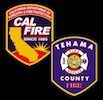North West Tehama County
Battalion III lies in the northwest portion of Tehama County and includes the communities of Lake California, Bowman, Dibble Creek, R-Wild Horse Ranch, Ridgeway, and Red Bank. The Battalion runs from the I-5 corridor, through west Red Bluff, to the western border of Trinity and Mendocino National Forests and the Yolla Bolly Wilderness Area. The Battalion runs from the Shasta County line in the north to the Red Bank area in the south.
Many residential and associated structures on large lot or ranchette settings are considered values at risk. Livestock grazing, recreation, and timber harvesting are economically important activities in the Battalion. In addition, high voltage electrical lines and underground natural gas lines run through the Battalion. This infrastructure is significant, not only affecting the Tehama Glenn Unit, but the entire state of California.
Topography within Battalion III consists of flat valley terrain in the east that transitions to rolling foothills and steep mountain topography of the Coastal Range on the western edge of Tehama County. This area includes several major drainages running west to east, including Cottonwood Creek (Middle and South Fork), Elder Creek, and Salt Creek. These drainages have little access, forming steep canyons that promote rapid fire spread.
Grass and oak-woodland fuels are consistent throughout the valley and lower foothills. The mid slopes transition into heavy brush of Chamise and Manzanita, then Grey pines, until reaching the mixed Conifer forests of Beegum Peak and Tomhead Mountain at approximately 4500’ to 6000’ elevation. Large ranches and multiple structures are found throughout the mountainous areas.
The fire history in the area includes many catastrophic fires and lightning complexes that resulted in large acreages burned and structures destroyed, such as the Elkhorn and Skinner Mill Fires. Battalion III lies within the same mountain chain and just north of the 1953 Rattlesnake Fire which claimed the lives of 15 firefighters. Fires occurring in the Battalion travel quickly in the grass fuels and transition to the steep mixed brush. This presents significant control challenges and the potential for large fire growth. Lightning strikes often cause multiple fires that are difficult to access. Deep marine layers, valley heating, and diurnal winds often lead to a local weather influence of significant downslope and sundowner winds from the west. These wind shifts can happen very quickly.
Priorities for Battalion III include utilizing vegetation management practices to reduce and modify fuel loading and working with Caltrans and the Tehama County Road Department on roadside fuel modification projects to identify, construct, and maintain fuel break locations. In addition, the Battalion is focusing on developing and improving water sources used for fire protection. Battalion III conducts annual residential defensible space inspections, conducts power line inspections, and promotes fire prevention education.
Battalion III collaborates with stakeholders and the Resource Conservation District of Tehama County to continue improvements and maintenance of the fuel reduction and roadside fuel modification projects. There are multiple projects already underway in the Battalion, including the Hwy 36 West fuel reduction project, the Bowman Road right-of-way clearance, the Lake California fuel reduction project, the Pattymocus Lookout fuel reduction, the Pellows Road grading project, and the Western Tehama Roadside Fuels project in the Bowman Area. Additional fuel reduction projects are in the planning phases including, the Matlock Loop and Oakwood Heights Drive fuel reduction projects. Battalion III has several active Vegetation Management Plans (VMP), including the Sunflower VMP, the Bengard Ranch VMP, the Corning Land and Cattle Company VMP and the R Wild Horse Ranch VMP. The goal of all the VMP’s in the Battalion is to reduce fuels that promote fire spread and growth and conduct prescribed fire burns.
Protection of life, property and resources in Battalion III is the highest priority. Aggressive initial fire attack, sound vegetation management practices, effective public education, code enforcement and cooperation among stakeholders is the key to accomplishing those goals.
